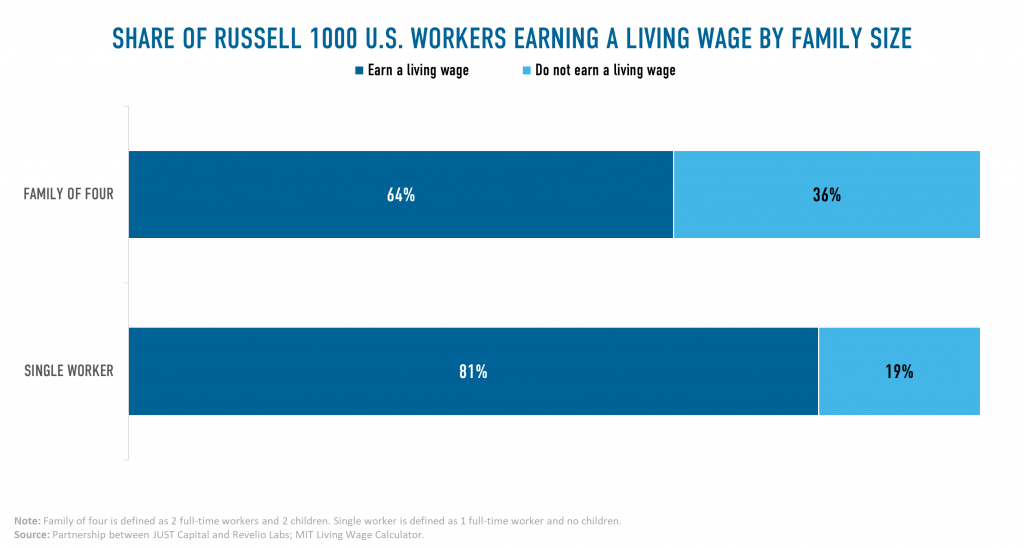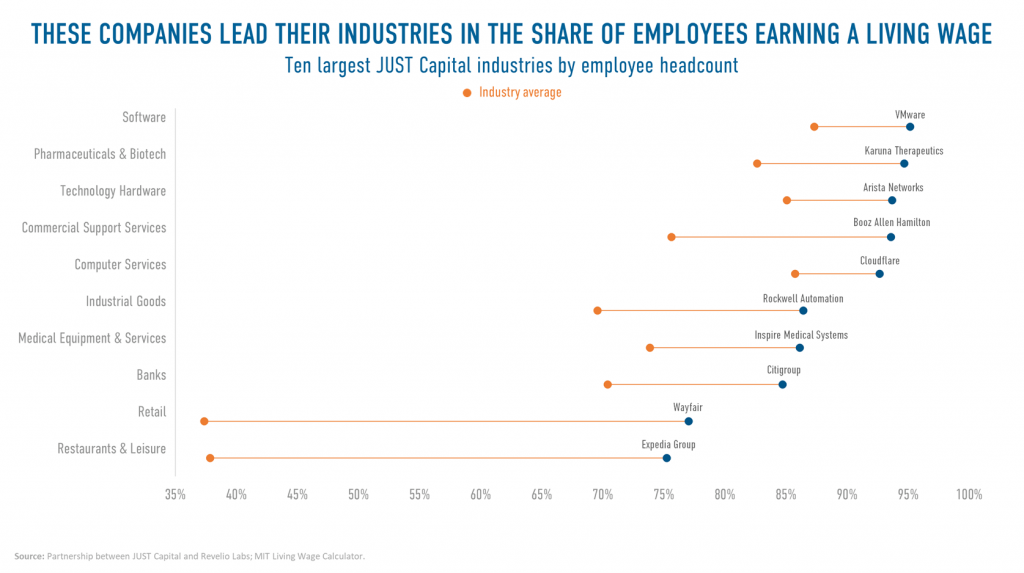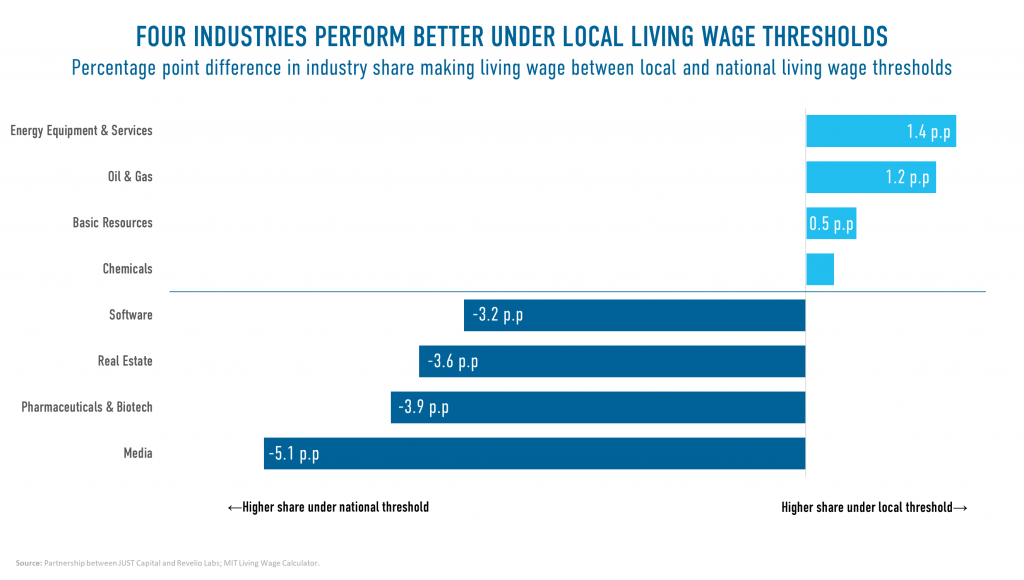More Than 36% of Russell 1000 Workers Don’t Make a Family-Sustaining Living Wage

By Aleksandra Radeva, Lisa Simon, and James Enright
Americans care that companies pay a fair, living wage. In fact, JUST Capital’s report “2023 Issues Survey – The People’s Priorities,” which measures the business issues most important to the public, found that paying a fair, living wage was the highest priority for a fourth consecutive year, garnering widespread support as the top issue across almost every demographic group. In a year marked by high inflation and increasing cost of living around the country, the focus on living wages – or a wage rate that allows workers to meet basic budgetary needs – comes as no surprise.
To gain deeper understanding of wages at Russell 1000 companies, JUST Capital continued its partnership with Revelio Labs, a workforce intelligence company that provides data and insights on employment at any company by using advanced techniques in machine learning.
Many Full-Time Workers Struggle to Make Ends Meet
This year’s results of the joint analysis show that among all U.S.-based Russell 1000 workers, 36.3% of workers are not making a family-sustaining living wage. That’s about 6.1 million full-time workers who are not making enough to support a family with another full-time working adult and two children. The analysis further estimates that about 19.2% of Russell 1000 workers do not earn enough to meet their own basic needs – or a living wage for one full-time employee without dependents.

These estimates are generated through the cutting-edge modeling techniques deployed by Revelio Labs. By absorbing and standardizing hundreds of millions of public employment records, Revelio Labs is able to infer employment compositions at any company, like how many people work at a company, the composition of workers in terms of roles and backgrounds or demographics, where a company’s workers live, and what those workers earn. In collaboration with JUST Capital, Revelio produces estimates for three data points used to measure performance on wages across America’s largest companies. To learn more about how these estimates are derived and how they feed into JUST Capital’s annual ranking of America’s Most JUST Companies, read our methodology summary or dig deeper into our full methodology.
Russell 1000 companies are the highest-performing public companies – and their workers, who make up around 10% of the U.S. workforce, earn more on average than other workers. In 2023, the median worker in the US earned $58,084 annually, according to the Bureau of Labor Statistics, while the median Russell 1000 worker earned 26.2% more – or $73,305. Russell 1000 workers also enjoyed higher wage gains in 2023, compared to average workers, which provided them with a slight advantage when weathering cost of living increases in 2023.
Industries naturally vary by their share of workers earning a living wage, depending on their composition of high-wage and lower-wage earners. Software and Biotech tend to have very high living wage scores, for example, as they typically employ many high wage earners and fewer workers in roles such as production or retail, which tend to be lower paid. Nevertheless, large variation in the share of workers earning a living wage exists within industries as well. This intra-industry range is evident in the chart below, which shows the difference between the average and highest shares of employees earning a living wage for a selection of industries. In the Industrial Goods industry, the difference is particularly striking – on average only 70% of workers in the industry are estimated to earn a living wage, but Rockwell Automation is estimated to pay almost 90% of its workers a living wage. Wayfair and Expedia also far outperform their industry average because their employee composition and core business differ from their industry peers, more closely resembling Tech companies than Retail and Restaurant and Leisure companies, respectively.

How Does Geography Affect Living Wages?
Last year, we compared all Russell 1000 worker salaries to one population-weighted national living wage threshold, no matter where a worker lives and works. This geographically generalized approach creates some unfair comparisons two ways: The relatively higher wage rates of workers in high-cost-of-living areas were being compared to a national cost-of-living threshold that was much too low compared to the cost those workers actually face. For example, the regional threshold for a two-adult, two-children household in the metropolitan area of New York City is $30.79 – 23% higher than the average national living wage threshold in 2023, $25.02. On the other hand, workers in low-cost areas of the country were being held to a much higher threshold than locally necessary. This year, Revelio Labs and JUST Capital decided to adopt a localized approach and compare worker salaries to the living wage threshold in their metropolitan area – a more ‘just’ comparison for everyone.
Interestingly, the difference in methodology makes little difference in the average share of workers earning a living wage. Under the national threshold, 65.4% of workers make a living wage, as opposed to 63.7% in the local threshold. The slightly lower share under the local threshold suggests that relatively more Russell 1000 workers live in high-cost areas. Comparing their wages to a local threshold makes it harder to meet the threshold.
This is not true across all industries. Some industries fare better using local thresholds, while most industries do slightly worse. The industries with higher shares of workers earning a living wage using geographically-specific thresholds are those with high concentrations of workers living in low-cost-of-living areas. Energy, Big Oil, and Chemical industries saw the greatest positive shift in the share of workers making a living wage. Media companies, on the other hand, have a higher share of workers in high-cost metropolitan areas, and their performance falters with the application of the correspondingly higher local living wage thresholds.

In the coming weeks, we’ll use further insights from these wage models to explore how America’s largest companies align with the increasing priority Americans place on creating equitable and just jobs.
We invite you to continue learning about the power of a living wage and its important role as a corporate threshold in this explainer co-authored by JUST Capital and MIT Living Wage Calculator. You can explore what prioritizing employees’ financial wellness looks like through the stories of companies participating in the Worker Financial Wellness Initiative, implemented in partnership with PayPal, Financial Health Network, and Good Jobs Institute. And if you’d like to participate in JUST Capital’s growing network of corporate leaders committed to advancing worker wellbeing, please reach out at impact@justcapital.com to request more information or a conversation.
If you would like to learn more about the methodology behind JUST Capital’s and Revelio Labs’ wage models or your company’s performance in them, please reach out to our corporate engagement team at corpengage@justcapital.com.
If you would like more information or access to company workforce data, including salaries, headcounts, or employee composition to benchmark your company to your peers, please reach out to info@reveliolabs.com.
Lisa Simon is the Chief Economist and James Enright is a Research Analyst at Revelio Labs.






